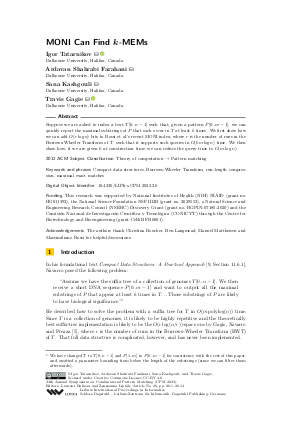MONI Can Find k-MEMs
Authors
Igor Tatarnikov  ,
Ardavan Shahrabi Farahani,
Sana Kashgouli,
Travis Gagie
,
Ardavan Shahrabi Farahani,
Sana Kashgouli,
Travis Gagie 
-
Part of:
Volume:
34th Annual Symposium on Combinatorial Pattern Matching (CPM 2023)
Part of: Series: Leibniz International Proceedings in Informatics (LIPIcs)
Part of: Conference: Annual Symposium on Combinatorial Pattern Matching (CPM) - License:
 Creative Commons Attribution 4.0 International license
Creative Commons Attribution 4.0 International license
- Publication Date: 2023-06-21
File

PDF
LIPIcs.CPM.2023.26.pdf
- Filesize: 0.68 MB
- 14 pages
Document Identifiers
Subject Classification
ACM Subject Classification
- Theory of computation → Pattern matching
Keywords
- Compact data structures
- Burrows-Wheeler Transform
- run-length compression
- maximal exact matches
Metrics
- Access Statistics
-
Total Accesses (updated on a weekly basis)
0Document
0Metadata
Abstract
Suppose we are asked to index a text T [0..n - 1] such that, given a pattern P [0..m - 1], we can quickly report the maximal substrings of P that each occur in T at least k times. We first show how we can add O (r log n) bits to Rossi et al.’s recent MONI index, where r is the number of runs in the Burrows-Wheeler Transform of T, such that it supports such queries in O (k m log n) time. We then show how, if we are given k at construction time, we can reduce the query time to O (m log n).
Cite As Get BibTex
Igor Tatarnikov, Ardavan Shahrabi Farahani, Sana Kashgouli, and Travis Gagie. MONI Can Find k-MEMs. In 34th Annual Symposium on Combinatorial Pattern Matching (CPM 2023). Leibniz International Proceedings in Informatics (LIPIcs), Volume 259, pp. 26:1-26:14, Schloss Dagstuhl – Leibniz-Zentrum für Informatik (2023)
https://doi.org/10.4230/LIPIcs.CPM.2023.26
BibTex
@InProceedings{tatarnikov_et_al:LIPIcs.CPM.2023.26,
author = {Tatarnikov, Igor and Shahrabi Farahani, Ardavan and Kashgouli, Sana and Gagie, Travis},
title = {{MONI Can Find k-MEMs}},
booktitle = {34th Annual Symposium on Combinatorial Pattern Matching (CPM 2023)},
pages = {26:1--26:14},
series = {Leibniz International Proceedings in Informatics (LIPIcs)},
ISBN = {978-3-95977-276-1},
ISSN = {1868-8969},
year = {2023},
volume = {259},
editor = {Bulteau, Laurent and Lipt\'{a}k, Zsuzsanna},
publisher = {Schloss Dagstuhl -- Leibniz-Zentrum f{\"u}r Informatik},
address = {Dagstuhl, Germany},
URL = {https://drops.dagstuhl.de/entities/document/10.4230/LIPIcs.CPM.2023.26},
URN = {urn:nbn:de:0030-drops-179802},
doi = {10.4230/LIPIcs.CPM.2023.26},
annote = {Keywords: Compact data structures, Burrows-Wheeler Transform, run-length compression, maximal exact matches}
}
Author Details
Funding
This research was supported by National Institutes of Health (NIH) NIAID (grant no. HG011392), the National Science Foundation NSF IIBR (grant no. 2029552), a Natural Science and Engineering Research Council (NSERC) Discovery Grant (grant no. RGPIN-07185-2020) and the Comisión Nacional de Investigación Científica y Tecnológica (CONICYT) through the Centre for Biotechnology and Bioengineering (grant CeBiB FB0001).
Acknowledgements
The authors thank Christina Boucher, Ben Langmead, Manuel Mattheisen and Massimiliano Rossi for helpful discussions.
References
-
Hideo Bannai, Travis Gagie, and Tomohiro I. Refining the r-index. Theoretical Computer Science, 812:96-108, 2020.

-
Christina Boucher, Travis Gagie, Tomohiro I, Dominik Köppl, Ben Langmead, Giovanni Manzini, Gonzalo Navarro, Alejandro Pacheco, and Massimiliano Rossi. PHONI: Streamed matching statistics with multi-genome references. In 2021 Data Compression Conference (DCC), pages 193-202. IEEE, 2021.

-
Christina Boucher, Travis Gagie, Alan Kuhnle, Ben Langmead, Giovanni Manzini, and Taher Mun. Prefix-free parsing for building big BWTs. Algorithms for Molecular Biology, 14(1):1-15, 2019.

-
Nathaniel K. Brown, Travis Gagie, and Massimiliano Rossi. RLBWT tricks. In 20th Symposium on Experimental Algorithms (SEA 2022), pages 16:1-16:16, 2022.

-
Travis Gagie, Gonzalo Navarro, and Nicola Prezza. Fully functional suffix trees and optimal text searching in BWT-runs bounded space. Journal of the ACM (JACM), 67(1):1-54, 2020.

-
Juha Kärkkäinen, Dominik Kempa, and Marcin Piątkowski. Tighter bounds for the sum of irreducible LCP values. Theoretical Computer Science, 656:265-278, 2016.

-
Juha Kärkkäinen, Giovanni Manzini, and Simon J Puglisi. Permuted longest-common-prefix array. In 20th Symposium on Combinatorial Pattern Matching (CPM), pages 181-192. Springer, 2009.

- Heng Li. Aligning sequence reads, clone sequences and assembly contigs with BWA-MEM. arXiv preprint, 2013. URL: https://arxiv.org/abs/1303.3997.
-
Gonzalo Navarro. Compact Data Structures: A Practical Approach. Cambridge University Press, 2016.

- Gonzalo Navarro. Computing MEMs on repetitive text collections. arXiv preprint v3, 2022. Accepted to this conference. URL: https://arxiv.org/abs/2210.09914.
-
Takaaki Nishimoto, Shunsuke Kanda, and Yasuo Tabei. An optimal-time RLBWT construction in BWT-runs bounded space. In 49th International Colloquium on Automata, Languages, and Programming (ICALP 2022), pages 99:1-99:20, 2022.

-
Takaaki Nishimoto and Yasuo Tabei. Optimal-time queries on BWT-runs compressed indexes. In 48th International Colloquium on Automata, Languages, and Programming (ICALP 2021), 2021.

-
Massimiliano Rossi, Marco Oliva, Ben Langmead, Travis Gagie, and Christina Boucher. MONI: A pangenomic index for finding maximal exact matches. Journal of Computational Biology, 29(2):169-187, 2022.

